Characteristics of Dissolved Organic Matter as Affected by Decomposition of Different Organic Materials in Alpine Wetland
Abstract
:1. Introduction
2. Materials and Methods
2.1. Preparation of Organic Materials
2.2. Decomposition Experiment and Sampling
2.3. Measurement of Basic Properties
2.4. Three-Dimensional Excitation-Emission Matrix Fluorescence Spectroscopy (3D-EEM)
2.5. Statistical Analysis
3. Results
3.1. Basic Properties
3.2. Spectral Indices of DOM
3.3. DOM Components by EEM and Parallel Factor Analysis
3.4. Correlation of DOM Components with Basic Properties and Spectral Indices of DOM
4. Discussion
4.1. Chemical Characteristics of DOM in Decomposition of Different Organic Materials in Alpine Wetland
4.2. DOM Compositions in Decomposition of Different Organic Materials in Alpine Wetland
5. Conclusions
Supplementary Materials
Author Contributions
Funding
Data Availability Statement
Conflicts of Interest
References
- Zark, M.; Dittmar, T. Universal molecular structures in natural dissolved organic matter. Nat. Commun. 2018, 9, 3178. [Google Scholar] [CrossRef] [PubMed]
- Li, S.; Li, M.; Wang, G.; Sun, X.; Xi, B.; Hu, Z. Compositional and chemical characteristics of dissolved organic matter in various types of cropped and natural Chinese soils. Chem. Biol. Technol. Agric. 2019, 6, 20. [Google Scholar] [CrossRef]
- Nebbioso, A.; Piccolo, A. Molecular characterization of dissolved organic matter (DOM): A critical review. Anal. Bioanal. Chem. 2013, 405, 109–124. [Google Scholar] [CrossRef] [PubMed]
- Mostofa, K.M.G.; Liu, C.; Mottaleb, M.A.; Wan, G.; Ogawa, H.; Vione, D.; Yoshioka, T.; Wu, F. (Eds.) Dissolved organic matter in natural waters. In Photobiogeochemistry of Organic Matter; Springer: Berlin, Germany, 2013; pp. 1–137. [Google Scholar]
- Li, M.; Drosos, M.; Hu, H.; He, X.; Wang, G.; Zhang, H.; Hu, Z.; Xi, B. Organic amendments affect dissolved organic matter composition and mercury dissolution in pore waters of mercury-polluted paddy soil. Chemosphere 2019, 232, 356–365. [Google Scholar] [CrossRef]
- Bianchi, T.S.; Thornton, D.C.O.; Yvon-Lewis, S.A.; King, G.M.; Eglinton, T.I.; Shields, M.R.; Ward, N.D.; Curtis, J. Positive priming of terrestrially derived organic matter in a freshwater microcosm system. Geophys. Res. Lett. 2015, 42, 5460–5467. [Google Scholar] [CrossRef]
- Li, X.; Sun, G.X.; Chen, S.; Fang, Z.; Yuan, H.Y.; Shi, Q.; Zhu, Y.G. Molecular chemodiversity of dissolved organic matter in paddy soil. Environ. Sci. Technol. 2018, 52, 963–971. [Google Scholar] [CrossRef] [PubMed]
- Badalge, N.D.K.; Kim, J.; Lee, S.; Lee, B.; Hur, J. Land use effects on spatiotemporal variations of dissolved organic matter fluorescence and water quality parameters in watersheds, and their interrelationships. J. Hydrol. 2024, 631, 130840. [Google Scholar] [CrossRef]
- Li, J.; Zhao, L.; Li, M.; Min, Y.; Zhan, F.; Wang, Y.; Sheng, L.; Bian, H. Changes in soil dissolved organic matter optical properties during peatland succession. Ecol. Indic. 2022, 143, 109386. [Google Scholar] [CrossRef]
- Maurischat, P.; Lehnert, L.; Zerres, V.H.D.; Tran, T.V.; Kalbitz, K.; Rinnan, Å.; Li, X.G.; Dorji, T.; Guggenberger, G. The glacier-terrestrial-fluvial pathway: A multiparametrical analysis of spatiotemporal dissolved organic matter variation in three catchments of Lake Nam Co, Tibetan Plateau. Sci. Total Environ. 2022, 838, 156542. [Google Scholar] [CrossRef]
- Fellman, J.B.; Hood, E.; Spencer, R.G.M. Fluorescence spectroscopy opens new windows into dissolved organic matter dynamics in freshwater ecosystems: A review. Limnol. Oceanogr. 2010, 55, 2452–2462. [Google Scholar] [CrossRef]
- Castro, M.V.; García, P.E.; Testoni, M.C.M.; Rodríguez, P. Dissolved organic matter (DOM) characterization in subantarctic shallow lakes and beaver ponds. Aquat. Sci. 2023, 85, 72. [Google Scholar] [CrossRef]
- Gandois, L.; Teisserenc, R.; Cobb, A.R.; Chieng, H.I.; Lim, L.B.L.; Kamariah, A.S.; Hoyt, A.; Harvey, C.F. Origin, composition, and transformation of dissolved organic matter in tropical peatlands. Geochim. Cosmochim. Acta 2014, 137, 35–47. [Google Scholar] [CrossRef]
- Jayasekara, C.; Leigh, C.; Shimeta, J.; Silvester, E.; Grover, S. Organic matter decomposition in mountain peatlands: Effects of substrate quality and peatland decomposition. Plant Soil. 2024. [Google Scholar] [CrossRef]
- Gao, J.; Liang, C.; Shen, G.; Lv, J.; Wu, H. Spectral characteristics of dissolved organic matter in various agricultural soils throughout China. Chemosphere 2017, 176, 108–116. [Google Scholar] [CrossRef]
- Jiang, S.; Xiao, W.; Sun, J.; Wang, H.; Han, J.; Zhang, X. Decomposition and temperature sensitivity of litter-derived dissolved organic matter (DOM) in a temperate freshwater wetland. Plant Soil. 2023, 489, 697–709. [Google Scholar] [CrossRef]
- Chen, H.; Liu, X.; Blosser, G.D.; Rücker, A.M.; Conner, W.H.; Chow, A.T. Molecular dynamics of foliar litter and dissolved organic matter during the decomposition process. Biogeochemistry 2020, 150, 17–30. [Google Scholar] [CrossRef]
- Cui, Y.; Luo, F.L.; Chen, Y.H.; Zhang, M.X.; Yu, F.H. Rhizodeposition and litter decomposition of Phragmites australis play important roles in composition and properties of soil dissolved organic matter. Ecol. Indic. 2022, 142, 109275. [Google Scholar] [CrossRef]
- Cuss, C.W.; Guéguen, C. Distinguishing dissolved organic matter at its origin: Size and optical properties of leaf-litter leachates. Chemosphere 2013, 92, 1483–1489. [Google Scholar] [CrossRef]
- Chow, A.T.; Lee, S.T.; O’Geen, A.T.; Orozco, T.; Beaudette, D.; Wong, P.K.; Hernes, P.J.; Tate, K.W.; Dahlgren, R.A. Litter contributions to dissolved organic matter and disinfection byproduct precursors in California Oak Woodland watersheds. J. Environ. Qual. 2009, 38, 2334–2343. [Google Scholar] [CrossRef]
- Yan, L.; Xie, X.; Peng, K.; Wang, N.; Zhang, Y.; Deng, Y.; Gan, Y.; Li, Q.; Zhang, Y. Sources and compositional characterization of chromophoric dissolved organic matter in a Hainan tropical mangrove-estuary. J. Hydrol. 2021, 600, 126572. [Google Scholar] [CrossRef]
- Yang, Y.; Geng, J.; Cheng, S.; Fang, H.; Guo, Y.; Li, Y.; Zhou, Y.; Shi, F.; Vancampenhout, K. Linking soil microbial community to the chemical composition of dissolved organic matter in a boreal forest during freeze-thaw cycles. Geoderma 2023, 431, 116359. [Google Scholar] [CrossRef]
- Zhang, Z.; Qin, J.; Sun, H.; Yang, J.; Liu, Y. Spatiotemporal dynamics of dissolved organic carbon and freshwater browning in the Zoige alpine wetland, northeastern Qinghai-Tibetan Plateau. Water 2020, 12, 2453. [Google Scholar] [CrossRef]
- Wang, R.; He, M.; Niu, Z. Responses of alpine wetlands to climate changes on the Qinghai-Tibetan Plateau based on remote sensing. Chin. Geogr. Sci. 2020, 30, 189–201. [Google Scholar] [CrossRef]
- Song, K.; Li, S.; Wen, Z.; Lyu, L.; Shang, Y. Characterization of chromophoric dissolved organic matter in lakes across the Tibet-Qinghai Plateau using spectroscopic analysis. J. Hydrol. 2019, 579, 124190. [Google Scholar] [CrossRef]
- Du, Y.; Chen, F.; Xiao, K.; Song, C.; He, H.; Zhang, Q.; Zhou, Y.; Jang, K.-S.; Zhang, Y.; Xing, P.; et al. Water residence time and temperature drive the dynamics of dissolved organic matter in alpine lakes in the Tibetan Plateau. Global Biogeochem. Cycles 2021, 35, e2020GB006908. [Google Scholar] [CrossRef]
- Li, M.; Zhang, K.; Yan, Z.; Liu, L.; Kang, E.; Kang, X. Soil water content shapes microbial community along gradients of wetland decomposition on the Tibetan Plateau. Front. Microbiol. 2022, 13, 824267. [Google Scholar]
- Ohno, T. Fluorescence inner-filtering correction for determining the humification index of dissolved organic matter. Environ. Sci. Technol. 2002, 36, 742–746. [Google Scholar] [CrossRef]
- Liu, C.; Li, Z.; Berhe, A.A.; Xiao, H.; Liu, L.; Wang, D.; Peng, H.; Zeng, G. Characterizing dissolved organic matter in eroded sediments from a loess hilly catchment using fluorescence EEM-PARAFAC and UV-Visible absorption: Insights from source identification and carbon cycling. Geoderma 2019, 334, 37–48. [Google Scholar] [CrossRef]
- Ren, W.; Wu, X.; Chen, B.; Chao, J.; Ge, X.; Yang, J.; Yang, H. Optical characteristics of chromophoric dissolved organic matter (CDOM) in upstream and downstream lakes of Taihu lake basin: New insights for water environmental management. Chin. Geogr. Sci. 2022, 32, 606–619. [Google Scholar] [CrossRef]
- Cleveland, C.C.; Neff, J.C.; Townsend, A.R.; Hood, E. Composition, dynamics, and fate of leached dissolved organic matter in terrestrial ecosystems: Results from a decomposition experiment. Ecosystems 2004, 7, 275–285. [Google Scholar] [CrossRef]
- Zhou, Y.; Martin, P.; Müller, M. Composition and cycling of dissolved organic matter from tropical peatlands of coastal Sarawak, Borneo, revealed by fluorescence spectroscopy and parallel factor analysis. Biogeosciences 2019, 16, 2733–2749. [Google Scholar] [CrossRef]
- Wu, D.; Ren, C.; Ren, D.; Tian, Y.; Li, Y.; Wu, C.; Li, Q. New insights into carbon mineralization in tropical paddy soil under land use conversion: Coupled roles of soil microbial community, metabolism, and dissolved organic matter chemodiversity. Geoderma 2023, 432, 116393. [Google Scholar] [CrossRef]
- Maurischat, P.; Seidel, M.; Dittmar, T.; Guggenberger, G. Complex dissolved organic matter (DOM) on the roof of the world—Tibetan DOM molecular characteristics indicate sources, land use effects, and processing along the fluvial—Limnic continuum. Biogeosciences 2023, 20, 3011–3026. [Google Scholar] [CrossRef]
- Tfaily, M.M.; Hamdan, R.; Corbett, J.E.; Chanton, J.P.; Glaser, P.H.; Cooper, W.T. Investigating dissolved organic matter decomposition in northern peatlands using complimentary analytical techniques. Geochim. Cosmochim. Acta 2013, 112, 116–129. [Google Scholar] [CrossRef]
- Muller, F.L.; Chang, K.C.; Wang, Y.C.; Lee, C.L. A study of peatland-derived dissolved organic matter from headstream to sea using multiple analytical tools. Environ. Sci. Pollut. R. 2023, 30, 23386–23397. [Google Scholar] [CrossRef]
- Reader, H.E.; Thomas, F.; Voss, M.; Stedmon, C.A. The influence of sediment-derived dissolved organic matter in the Vistula river estuary/gulf of Gdansk. J. Biogeosci. 2019, 124, 115–126. [Google Scholar] [CrossRef]
- Regier, P.; Larsen, L.; Cawley, K.; Jaffé, R. Linking hydrology and dissolved organic matter characteristics in a subtropical wetland: A long-term study of the Florida everglades. Glob. Biogeochem. Cycles 2020, 34, e2020GB006648. [Google Scholar] [CrossRef]
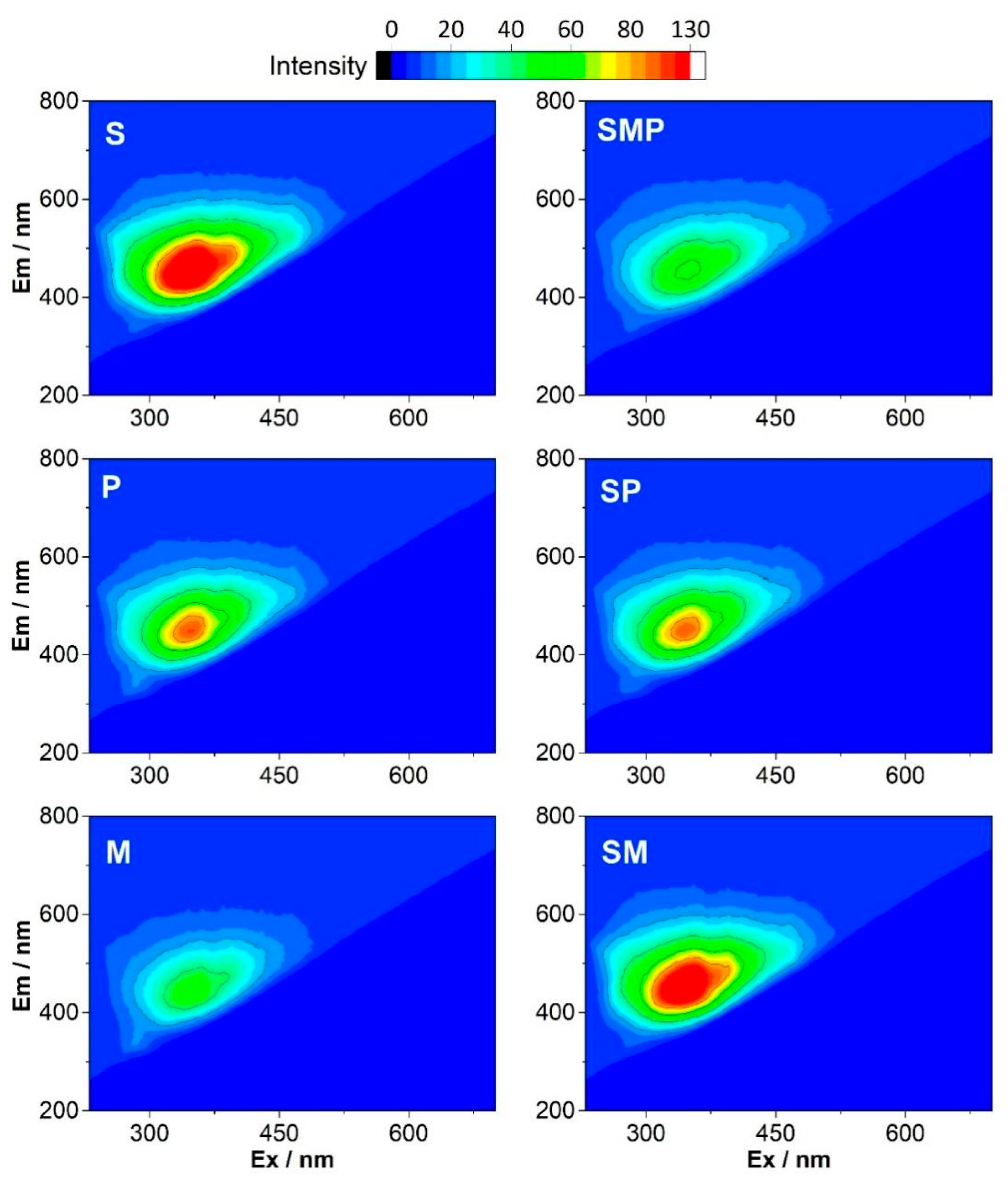
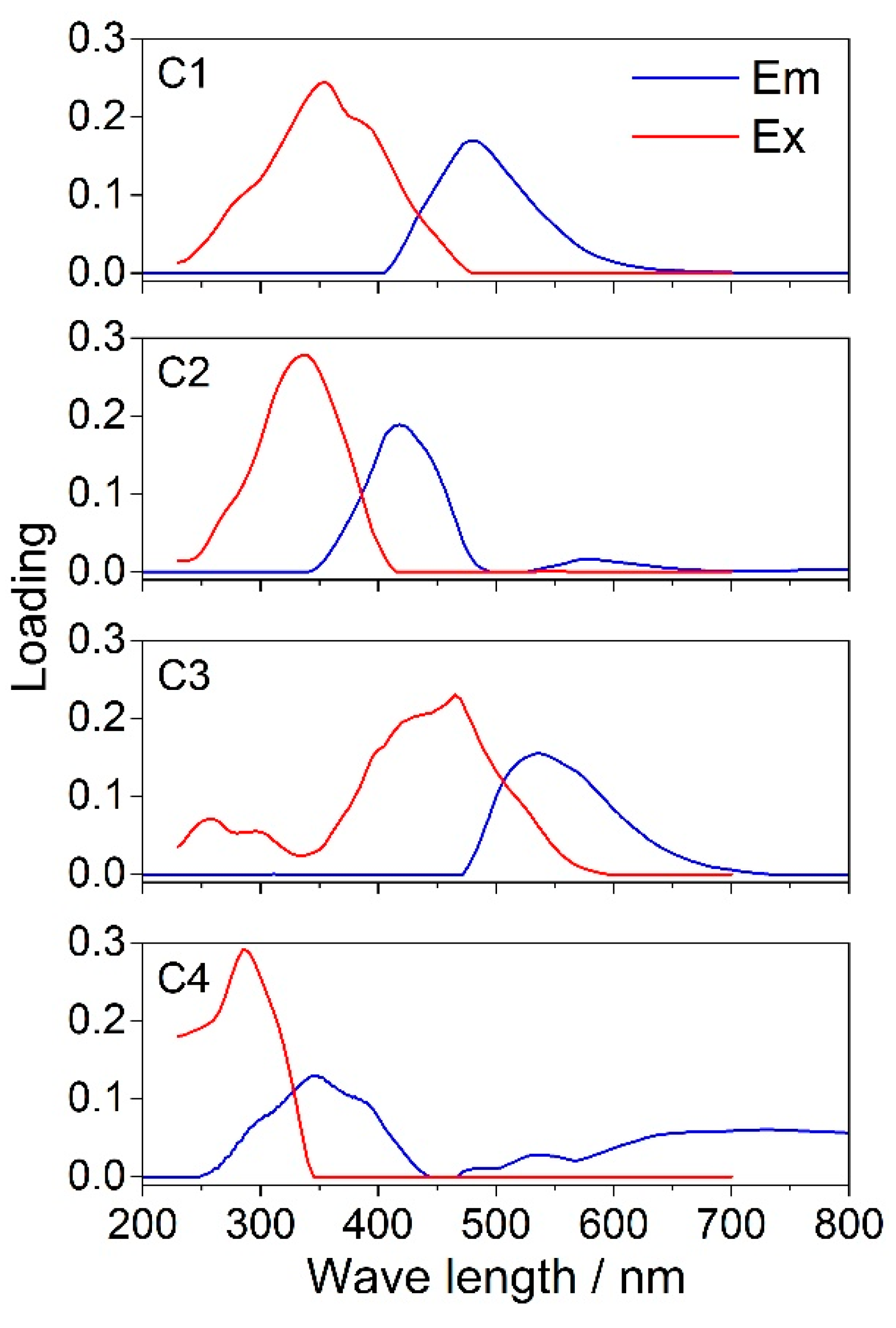
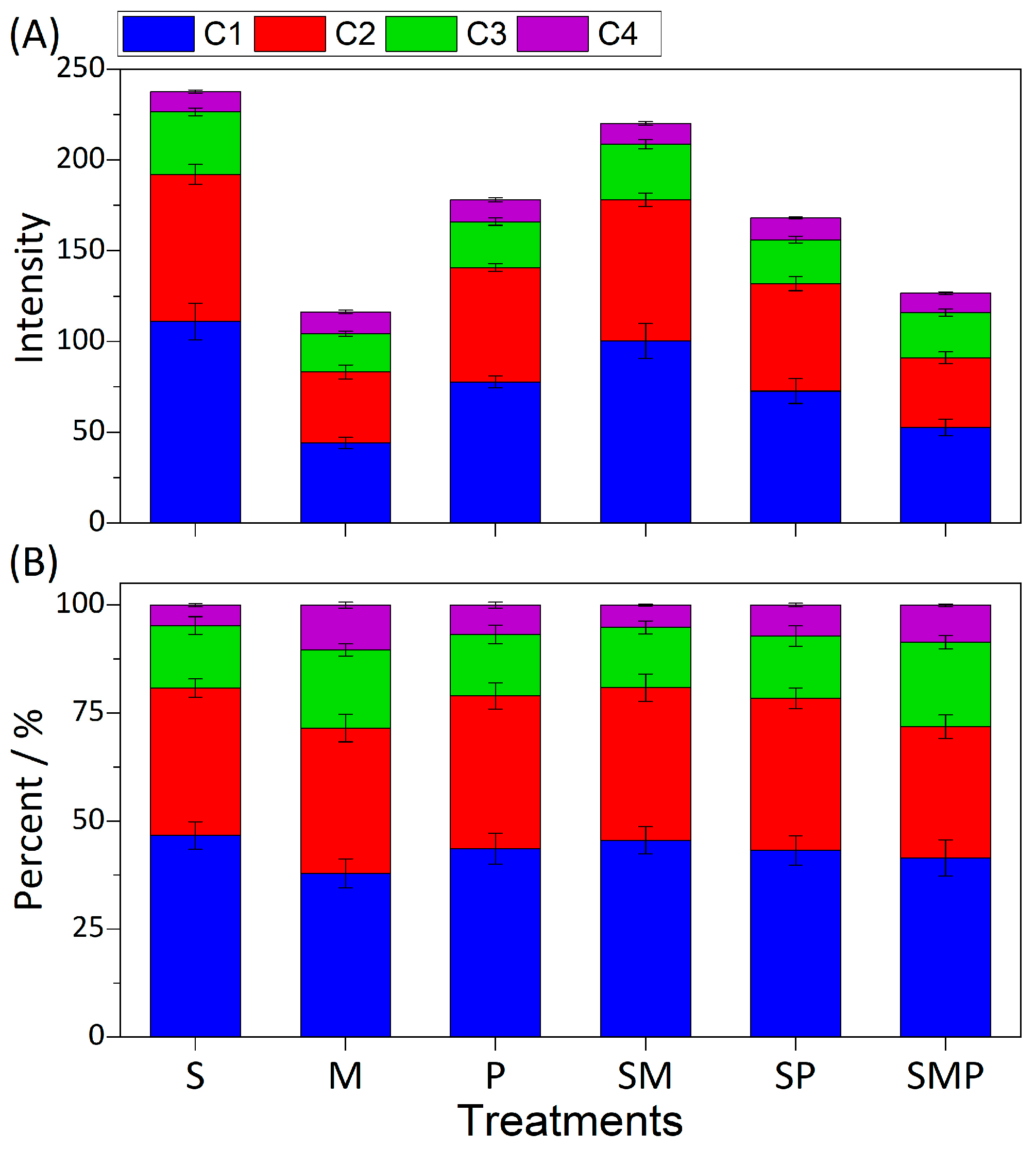
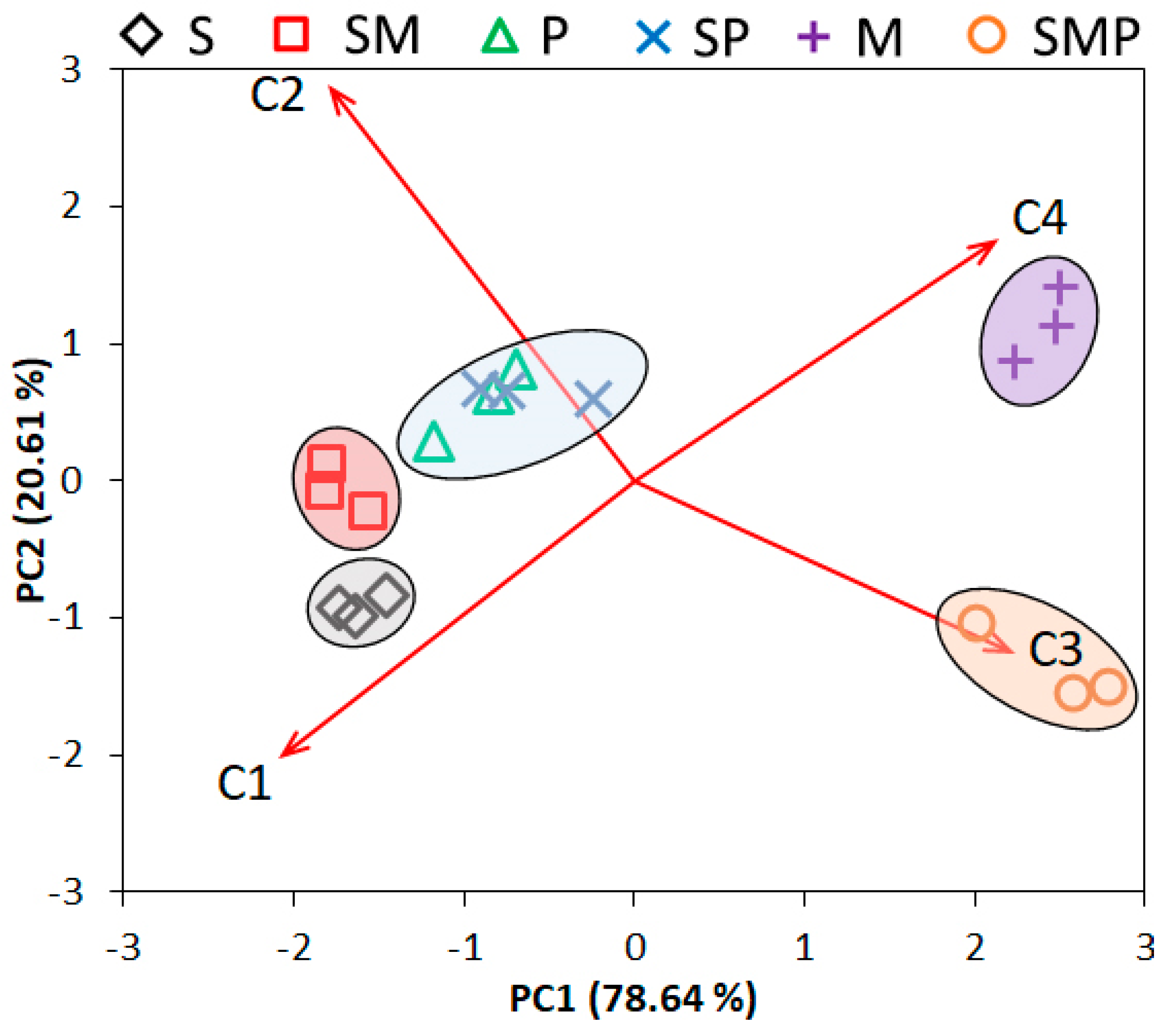
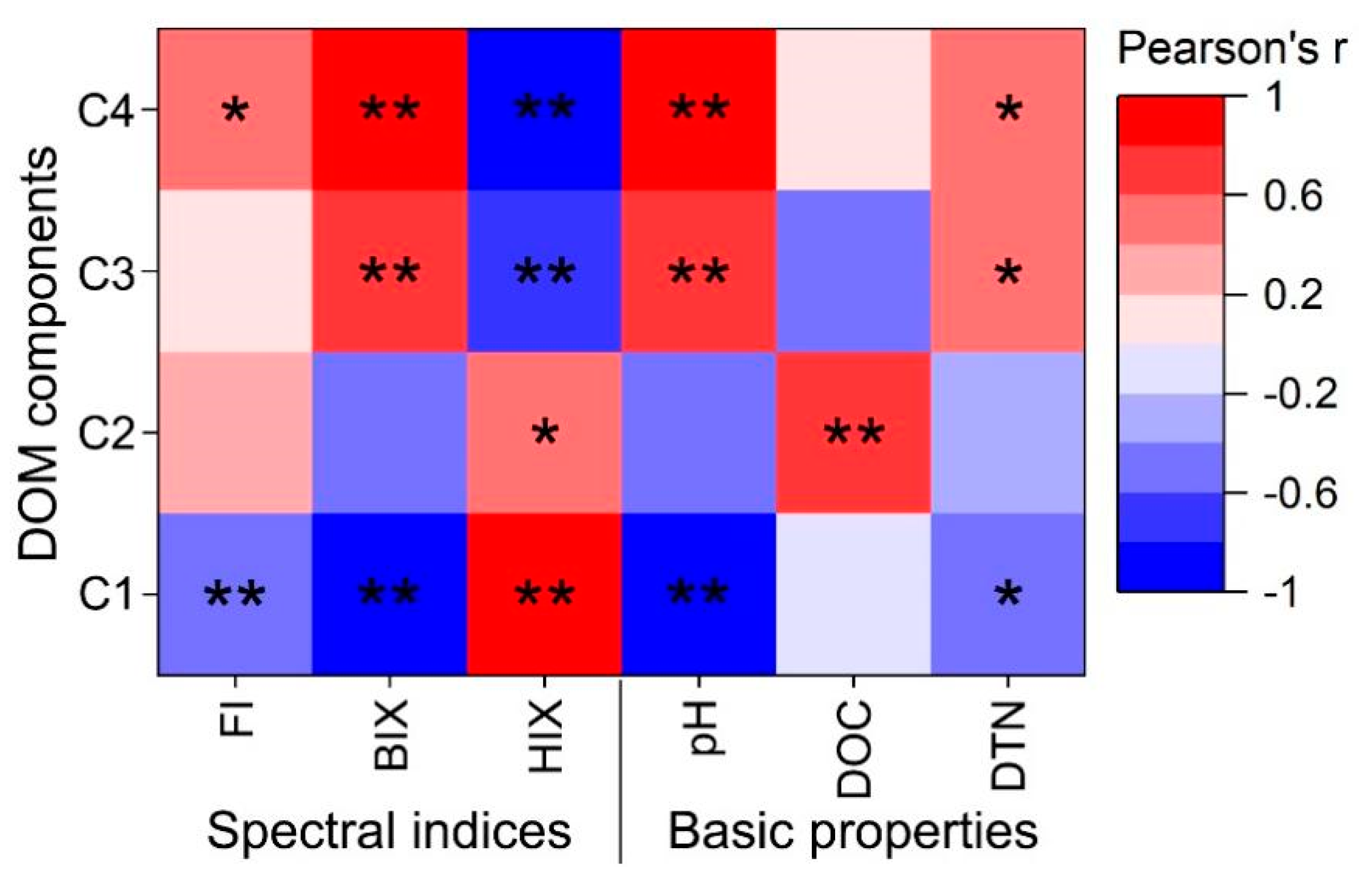
| Treatments | pH | DOC/mg L−1 | DTN/mg L−1 | DOC/DTN | P/mg L−1 | K/mg L−1 | Fe/mg L−1 | Ca/mg L−1 |
|---|---|---|---|---|---|---|---|---|
| S | 8.49 ± 0.05 b | 128.83 ± 17.89 c | 11.91 ± 0.55 b | 10.83 ± 0.42 b | 0.086 ± 0.010 b | 32.56 ± 4.29 a | 0.084 ± 0.011 a | 49.71 ± 7.58 a |
| M | 8.75 ± 0.08 a | 179.66 ± 11.95 b | 15.44 ± 0.67 a | 11.64 ± 0.93 b | 0.121 ± 0.016 a | 35.96 ± 5.81 a | 0.089 ± 0.012 a | 55.68 ± 6.42 a |
| P | 8.57 ± 0.09 b | 213.44 ± 10.93 a | 10.56 ± 0.31 b | 20.23 ± 1.62 a | 0.099 ± 0.014 ab | 41.85 ± 6.72 a | 0.079 ± 0.017 a | 51.82 ± 8.33 a |
| SP | 8.43 ± 0.05 c | 254.73 ± 12.26 a | 11.61 ± 0.33 b | 21.96 ± 1.46 a | 0.092 ± 0.011 b | 37.82 ± 5.22 a | 0.091 ± 0.016 a | 49.69 ± 6.95 a |
| SM | 8.51 ± 0.05 c | 148.36 ± 22.82 bc | 13.75 ± 0.27 ab | 10.78 ± 3.10 b | 0.122 ± 0.020 a | 34.98 ± 4.96 a | 0.085 ± 0.014 a | 48.35 ± 7.86 a |
| SMP | 8.58 ± 0.05 b | 197.33 ± 16.42 b | 13.09 ± 0.37 ab | 8.22 ± 1.43 b | 0.125 ± 0.019 a | 37.43 ± 4.37 a | 0.093 ± 0.023 a | 52.74 ± 6.99 a |
| Treatments | FI | BIX | HIX |
|---|---|---|---|
| S | 1.458 ± 0.039 c | 0.418 ± 0.011 c | 2.907 ± 0.128 a |
| M | 1.612 ± 0.030 a | 0.578 ± 0.016 a | 1.524 ± 0.053 c |
| P | 1.524 ± 0.026 ab | 0.459 ± 0.008 bc | 2.327 ± 0.125 b |
| SM | 1.485 ± 0.007 bc | 0.430 ± 0.006 c | 2.770 ± 0.071 ab |
| SP | 1.440 ± 0.066 c | 0.501 ± 0.010 ab | 2.260 ± 0.046 c |
| SMP | 1.514 ± 0.079 bc | 0.463 ± 0.028 bc | 2.165 ± 0.293 b |
Disclaimer/Publisher’s Note: The statements, opinions and data contained in all publications are solely those of the individual author(s) and contributor(s) and not of MDPI and/or the editor(s). MDPI and/or the editor(s) disclaim responsibility for any injury to people or property resulting from any ideas, methods, instructions or products referred to in the content. |
© 2024 by the authors. Licensee MDPI, Basel, Switzerland. This article is an open access article distributed under the terms and conditions of the Creative Commons Attribution (CC BY) license (https://creativecommons.org/licenses/by/4.0/).
Share and Cite
Song, Y.; Li, M.; Wang, Y.; Yang, W. Characteristics of Dissolved Organic Matter as Affected by Decomposition of Different Organic Materials in Alpine Wetland. Agronomy 2024, 14, 1979. https://doi.org/10.3390/agronomy14091979
Song Y, Li M, Wang Y, Yang W. Characteristics of Dissolved Organic Matter as Affected by Decomposition of Different Organic Materials in Alpine Wetland. Agronomy. 2024; 14(9):1979. https://doi.org/10.3390/agronomy14091979
Chicago/Turabian StyleSong, Yueguang, Meng Li, Yifei Wang, and Weishan Yang. 2024. "Characteristics of Dissolved Organic Matter as Affected by Decomposition of Different Organic Materials in Alpine Wetland" Agronomy 14, no. 9: 1979. https://doi.org/10.3390/agronomy14091979




